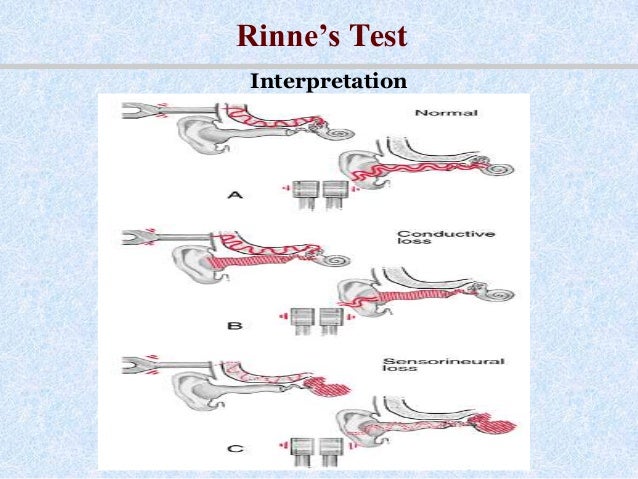
In a patient with a profound, unilateral sensorineural hearing loss, there may be a false negative Rinne due to the response of the normal ear i.e., AC>BC in the affected ear, but both of these thresholds are elevated relative to BC in the normal ear, so the patient reports that bone conduction is louder (they're actually hearing the tone in their normal ear, rather than their tested - i.e. In a person with a conductive hearing loss, bone conduction is greater than air conduction (BC > AC bone threshold is less than air threshold) A Rinne test should always be accompanied by a Weber test to also detect sensorineural hearing loss and thus confirm the nature of hearing loss. You put tuning fork on the grill (forehead). When person can no longer hear the sound (bone conduction threshold), place the tuning fork near the ear canalĪsk when the person can no longer hear the sound (air conduction threshold)ĭue to the amplification provided by the middle ear, in a normal person air threshold BC) The Weber test involves placing a 512Hz tuning fork in the middle of the forehead of a patient and asking the patient to indicate to which ear the sound is. This is the same thing that happens in the test for conductive deafness, thus sound is louder on the side of conductive deafness. This determination allows a doctor to come up with a treatment plan for your hearing changes. They help determine whether you may have conductive or sensorineural hearing loss. physicians typically use tuning forks of either 256 or 512 Hz (i.e., low frequencies of human hearing), which means that they are testing the stiffness component of the middle ear's acoustic impedance, which is determined by the volume of the middle ear space Studyquestions Novem0 11 What is Weber and Rinne test Rinne and Weber tests are exams that test for hearing loss.Strike tuning fork and place on mastoid process The Weber, Rinne and Bing tests were examined in normally hearing and hearing impaired subjects, using different techniques. There's more to see - the rest of this topic is available only to subscribers.PURPOSE: determination of a conductive hearing loss Weber Test: Same tone loudness heard equally in both ears.Ĭritical Findings and Potential Interventions.Schwabach Test: Same tone loudness heard equally long by the examiner and the patient.Rinne Test: Longer and louder tone heard by air conduction than by bone conduction ( Note: This result, observed in patients with normal hearing, is also observed in patients with sensorineural hearing loss.).Bing Test: Pulsating sound that gets louder and softer when the opening to the ear canal is alternately opened and closed ( Note: This result, observed in patients with normal hearing, is also observed in patients with sensorineural hearing loss.) These are a bedside assessment of hearing 2.early descriptions of the so-called tuning fork tests of Weber, Rinne, Schwabach and Bing. Results: Patients with CHL were more likely to produce a negative Rinne test with a steel fork than with an aluminum fork. Bench top measurements using sound-level meter, microphone, and artificial mastoid. The Rinne test is a tuning fork test that is used to assess the conduction of sound. Tuning Forks: The Problem Of Striking - Volume 103 Issue 1. Rinne test results using aluminum and steel forks were compared and correlated with the audiometric air-bone gap. Normal air and bone conduction in both ears no evidence of hearing loss for hearing loss through the finger rub test and by whispering.There are no food, fluid, activity, or medication restrictions unless by medical direction. Patients with CHL were more likely to produce a negative Rinne test with a steel fork than with an aluminum fork. The use of 128 Hz or 256 Hz tuning forks did not significantly modify the Rinne and Weber utility. To assess for and determine type of hearing loss. The diagnostic concordance between the findings in bedside tests and tonal audiometry was poor: (Kappa concordance coefficient: 0.38 for the 128 Hz tuning fork and 0.37 for the 256 Hz tuning fork). Heinrich Adolph Rinne (1819-1868), a German otologist, proposed the test, which was subsequently named.



Both of these tests are now routinely taught in medical schools and performed regularly to assess patients with hearing problems. Bing test, Rinne test, Schwabach test, Weber test. Over the years, many types of tuning forks tests had been developed to assess hearing loss, but today only two have withstood the test of time: Rinne and Weber.


 0 kommentar(er)
0 kommentar(er)
